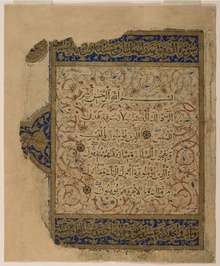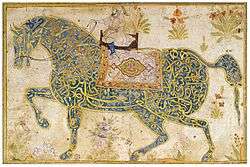Al-Baqara
| البقرة Al-Baqarah The Heifer | |
|---|---|
|
Arabic text · English translation | |
| Classification | Medinan |
| Position | Juzʼ 1–3 |
| Number of Rukus | 40 |
| Number of verses | 286 |
| Opening muqaṭṭaʻāt | Alif Lam Mim |
| Quran |
|---|
 |
|

The Cow or Sūrat al-Baqarah (Arabic: سورة البقرة, "The Cow") is the second and longest chapter (Surah) of the Qur'an.[1] It is a Medinan sura (revealed to Muhammad when he was at Medina), with the exception of verse 281 which Muslims believe was revealed during The Farewell Pilgrimage.[2] It is also considered to be one of the first chapters revealed after the Hijra from Mecca to Medina.[3] The chapter comprises 286 verses (ayat) according to the division of Ali, the most widely accepted count among all Muslim denominations,[2] and includes the single longest verse in the Qur'an (2:282).[4] The surah's name references verses 66–72 which recall the story of a heifer sacrificed by the Israelites.[2]
Surah al-Baqarah enjoins fasting on the believer during the month of Ramadan.[5]
Background
Al-Baqarah is the longest surah of the Quran, having 286 verses. According to Muslim belief, this Medinan Surah was not revealed at once to Muhammad, but the various Islamic social circumstances and conditions are discussed among verses.[6] Verse 281 is believed by Muslims to have been revealed during The Farewell Pilgrimage in Mecca.[2] It is also considered to be one of the first chapters revealed after the Hijra from Mecca to Medina.[3]
Theme and subject matter
The surah addresses a wide variety of topics, including substantial amounts of law, and retells stories of Adam, Abraham and Moses. A major theme is guidance: urging the pagans (Al-Mushrikeen) and the Jews of Medina to embrace Islam, and warning them and the hypocrites (Munafiq) of the fate God had visited in the past on those who failed to heed his call.[6] The stories in this chapter are told to help the reader understand the theological conception of truth in Islam.[7] Condemnation of alcoholic beverages and gambling is also first found in the chapter,[8] and it is one of only four chapters in the Qur'an to refer to Christians as Nazarenes instead of the more frequent terms People of the Book or "Helpers of Christ."[9]
Al-Baqarah contains several verses dealing with the subject of warfare. Verses 2:190-194 are quoted on the nature of battle in Islam. The chapter also consists of five stories regarding God giving life to the dead, one story of God giving life to a dead animal (donkey) and one story regarding giving life to a bird.[10]
As a part of Lutheran efforts at translating the Qur'an in the 17th century, itinerant German orientalist Christian Ravis translated al-Baqarah along with Al-Fatiha and published bilingual versions in Amsterdam in 1646.[11]
The surah includes a few Islamic rules related to varying subjects, such as: prayers, fasting, Holy War on the path of God, the pilgrimage to Mecca, the change of the direction of prayer (Qiblah) from Jerusalem to Mecca, marriage and divorce, commerce, debt, and a great many of the ordinances concerning usury.[6]
Notable verses
Verse 255 is "The Throne Verse" ( آية الكرسي ʾāyatu-l-kursī). It is the most famous verse of the Qur'an and is widely memorized and displayed in the Islamic world due to its emphatic description of God's omnipotence in Islam.
Verse 256 is one of the most quoted verses in the Qur'an. It famously notes that "there is no compulsion in religion". Two other verses, 285 and 286, are sometimes considered part of "The Throne Verse".[12]
Verse 216 is noted for ordaining Jihad.
See also
References
- ↑ Salwa M. S. El - Awa, Introduction to Textual Relations in Qur'an, pg. 1. Part of the Routledge Studies in the Qur'an series. London: Routledge, 2005. ISBN 9781134227471
- 1 2 3 4 Mahmoud Ayoub, The Qurʾan and its interpreters, pg. 55. Albany: State University of New York Press, 1984. ISBN 9780791495469
- 1 2 Felicitas Meta Maria Opwis, Maṣlaḥah and the Purpose of the Law: Islamic Discourse on Legal Change from the 4th/10th to 8th/14th Century, pg. 296. Volume 31 of Studies in Islamic Law and Society. Leiden: Brill Publishers, 2010. ISBN 9789004184169
- ↑ "Physical Aspects of the Noble Qur'an". www.al-islam.org. Retrieved 2008-05-10.
- ↑ Michael Binyon, Fighting is 'allowed' during the holy month of fasting The Times, 18 December 1998
- 1 2 3 Sadr-'ameli Sayyid Abbas. "Surah Al-Baqarah, Chapter 2, Introduction". Al-islam. Retrieved 14 May 2015.
- ↑ R. G. Ghattas and Carol B. Ghattas, A Christian Guide to the Qur'an: Building Bridges in Muslim Evangelism, pg. 40. Kregel Academic, 2009. ISBN 9780825493423
- ↑ Kathryn Kueny, The Rhetoric of Sobriety: Wine in Early Islam, pg. 66. Albany: State University of New York Press, 2001. ISBN 9780791450536
- ↑ Karen Steenbrink, "Muslims and the Christian Other: Nasara in Qur'anic Readings." Taken from Mission is a Must: Intercultural Theology and the Mission of the Church, pg. 200. Eds. Frans Jozef Servaas Wijsen and Peter J. A. Nissen. Volume 40 of Church and Theology in Context Series. Amsterdam: Rodopi, 2002. ISBN 9789042010819
- ↑ "Uzair" (PDF). imedbham.webs. Retrieved 14 May 2015.
- ↑ Alastair Hamilton, "A Lutheran Translator for the Qur'an: A Late Seventeenth-Century Quest." Taken from The Republic of Letters And the Levant, pg. 197. Eds. Alastair Hamilton, Maurits H. Van Den Boogert and Bart Westerweel. Volume 5 of Intersections. Leiden: Brill Publishers, 2005. ISBN 9789004147614
- ↑ Prana Dev (2010). Spiritual Quest of a Baby Yogi: Journey Through Islam, Christianity, and Beyond. ISBN 978-1-4502-6904-9.
External links
| Wikisource has original text related to this article: |
- "The Cow", a manuscript, dating from the 13th-century, of the al-Baqarah via the World Digital Library
- Qur'anic Verses, a manuscript for al-Baqarah from the 13th-century
| Previous sura: Al-Fatiha |
Surah 2 | Next sura: Al-i-Imran |
| Arabic text | ||
| ||
